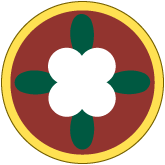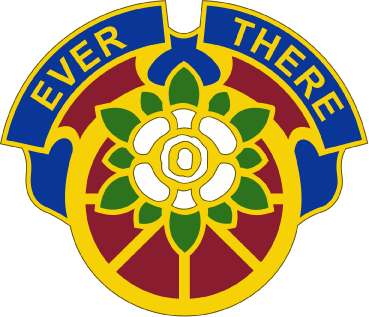The 31st Support Detachment and 114th Support Detachment carry no heraldic authorizations. Soldiers of these units wear the SSI and DUI of the 184th Sustainment Command.
 |
Organizational ColorsThe unit's organizational colors are the Shoulder Sleeve Insignia with a background color based on branch as defined by Army Regulation 840-10: Flags, Guidons, Streamers, Tabards, and Automobile and Aircraft Plates. |
 |
Shoulder Sleeve InsigniaDescription On a brick red disc 2 1/4 inches (5.72 cm) in diameter overall four green leaves surmounted at the center by a white quatrefoil, two points up, all within a 1/8 inch (.32 cm) yellow border. Symbolism Brick red is the color used for Transportation, the original unit designation. The white quatrefoil and the green leaves simulate a magnolia and refer to Mississippi, “The Magnolia State,” headquarters of the organization. The yellow outer band symbolizes a wheel and refers to transportation, the former mission of the unit. Background The shoulder sleeve insignia was originally approved for the 184th Transportation Command on 2 January 1969. It was redesignated for the 184th Transportation Brigade on 30 March 1972. The insignia was redesignated effective 1 September 2006, for the 184th Support Command with the description and symbolism updated. It was amended to correct the unit designation to 184th Sustainment Command on 28 July 2011. (TIOH Dwg. No. A-1-511) |
 |
Distinctive Unit InsigniaDescription A gold color metal and enamel device 1 1/8 inches (2.86 cm) in height overall consisting of a magnolia blossom (white flower with green leaves) in front of and surmounting the upper area of a gold wheel on a brick red background arched with a blue scroll, divided in two folds inscribed “EVER THERE” in gold letters. Symbolism Brick red and yellow (gold) are the colors used for Transportation, the original unit designation. The wheel represents the former mission of the unit and the magnolia alludes to the flower of the State of Mississippi, home area of the organization. Background The distinctive unit insignia was originally approved for the 184th Transportation Brigade on 2 June 1972. It was redesignated effective 1 September 2006, for the 184th Support Command with the description and symbolism updated. It was amended to correct the unit designation to 184th Sustainment Command on 28 July 2011. |
298th Support Battalion
 |
Organizational ColorsThe unit's organizational colors are the Coat of Arms with a background color based on branch as defined by Army Regulation 840-10: Flags, Guidons, Streamers, Tabards, and Automobile and Aircraft Plates. |
 |
Distinctive Unit InsigniaDescription A gold color metal and enamel device 1 1/8 inches (2.86 cm) in height overall consisting of a green driving tank sprocket bearing a gold closed gauntlet above a gold gear with a red center surmounted saltirewise by two blue open-end wrenches and all above a red scroll, the ends terminating at the corners of the sprocket, inscribed "IRE IN ADVERSA" in gold letters. Symbolism Crimson is the color traditionally associated with Maintenance, former designation of the unit. The green driving tank sprocket with gauntlet symbolizes the organization's former service as a tank battalion during World War II in Germany and Central Europe. The gauntlet also alludes to the administration and control functions of the unit's mission and, with the tank sprocket, wrenches, and gear, refers to weapons maintenance and transportation supply. The motto of the battalion, "IRE IN ADVERSA," translates, "To Advance Against Adversities." Background The distinctive unit insignia was originally approved for the 298th Maintenance Battalion on 11 September 1970. It was redesignated effective 15 May 1972 for the 298th Composite Battalion, on 22 March 1973 for the 298th Service Battalion, and on 16 November 1973 for the 298th Maintenance Battalion. It was finally redesignated to the 298th Support Battalion on 29 April 1996. |
 |
Coat of ArmsBlazon Shield: Crimson, a gear oon pierced Gules superimposed by two open-end wrenches in saltire Azure fimbriated of the second, on a canton Yellow a mullet of ten Vert charged with a dexter gauntlet erect, clenched appaume Gold. Crest: That for the regiments and separate battalions of the Mississippi Army National Guard: On a wreath of the colors Argent and Gules, a slip of magnolia full flower with leaves Proper behind a trident Sable. Motto: IRE IN ADVERSA (To Advance Against Adversities). Symbolism Shield: Crimson is the color traditionally associated with Maintenance, former designation of the unit. The canton with its star (alluding to a tank drive sprocket) and gauntlet symbolize the units' World War II service as a tank battalion in Germany and Central Europe (green and yellow are the traditional colors of armored units). The gear and wrenches allude to the mission of Maintenance units. Crest: The crest is that of the Mississippi Army National Guard. Background The coat of arms was originally approved for the 298th Support Battalion on 29 April 1996. |
168th Engineer Brigade
 |
Organizational ColorsThe unit's organizational colors are the Shoulder Sleeve Insignia with a background color based on branch as defined by Army Regulation 840-10: Flags, Guidons, Streamers, Tabards, and Automobile and Aircraft Plates. |
 |
Shoulder Sleeve InsigniaDescription On a vertical rectangular embroidered item, arched outwardly at top and bottom and divided diagonally from upper left to lower right, white and red, displaying in the center a yellow tower, windows and door light brown; all within a 1/8 inch (.32 cm) yellow border. The overall dimensions are 3 inches (7.62 cm) in height and 2 1/16 inches (5.24 cm) in width. Symbolism Red and white are the colors traditionally associated with the Engineer units. The tower denotes alertness and emphasizes the Brigade’s mission. The red and white background also references the Brigade’s past history as an Engineer Group. Background The shoulder sleeve insignia was approved on 18 June 2008. (TIOH Drawing Number A-1-970) |
 |
Distinctive Unit InsigniaDescription A gold color metal and enamel device 1 3/16 inches (3.02 cm) in height overall consisting of a vertical rectangular shape with circular upper and lower ends, bearing on a white base a gold demi-sun with rays (of similar delineation as that on the Philippine flag) charged with a vertical scarlet arrowhead, issuing from a gold wall masoned of four rows, in center overall a narrow blue saltire, the side interstices all of scarlet above the third masoned row of the wall and each interstices bearing a white five-pointed star, all enclosed by a continuous scarlet scroll (folded back and slightly undulating inwardly at the sides) inscribed at the top “MONUMENTS” and in base “TO PROGRESS” all in gold letters. Symbolism The two stars and arrowhead symbolize the unit’s two battle honors in World War II, New Guinea (with arrowhead) and Southern Philippines. The saltire was taken from the state flag of Mississippi and the blue color also alludes to the unit’s award of the Presidential Unit Citation (Army) for the Mindanao operation. The masoned wall symbolizes the unit’s building capabilities and also refers to the defense and fortifications at Vicksburg, guardian of the lower Mississippi and the home station of the unit. Scarlet and white are colors used by Engineer units. Background The distinctive unit insignia was originally approved for the 168th Engineer Group on 26 October 1970. It was redesignated for the 168th Engineer Brigade and amended to update the description and revise the symbolism on 13 May 2003. |
223d Engineer Battalion
 |
Organizational ColorsThe unit's organizational colors are the Coat of Arms with a background color based on branch as defined by Army Regulation 840-10: Flags, Guidons, Streamers, Tabards, and Automobile and Aircraft Plates. |
 |
Distinctive Unit InsigniaDescription A Silver color metal and enamel device 1 1/8 inches (2.86 cm) in height overall consisting of a shield blazoned: Gules, on a bend Argent winged of the like, a bendlet Sable charged with a bulldozer pulling a scraper all of the second. Attached below and to the sides a Silver scroll inscribed “CRESCIT LABORE” in Red letters. Symbolism Scarlet and white are the colors of the Corps of Engineers. The white winged bend - the bend representing an airstrip - refers to the Battalion’s primary mission of constructing airfields, the bulldozer and scraper being among the major tools used. The motto translates to “It Grows With Labor.” Background The distinctive unit insignia was originally approved for the 223d Engineer Aviation Battalion on 4 October 1955. It was redesignated for the 223d Engineer Battalion on 10 April 1957. |
 |
Coat of ArmsBlazon Shield: Gules, on a bend Argent winged of the like, a bendlet Sable charged with a bulldozer pulling a scraper all of the second. Crest: That for the regiments and separate battalions of the Mississippi Army National Guard: On a wreath of the colors Argent and Gules, a slip of magnolia full flower with leaves Proper behind a trident Sable. Motto: CRESCIT LABORE (It Grows With Labor). Symbolism Shield: Scarlet and white are the colors of the Corps of Engineers. The white winged bend - the bend representing an airstrip - refers to the Battalion’s primary mission of constructing airfields, the bulldozer and scraper being among the major tools used. Crest: The crest is that of the Mississippi Army National Guard. Background The coat of arms was originally approved for the 223d Engineer Aviation Battalion on 4 October 1955. It was redesignated for the 223d Engineer Battalion on 10 April 1957. |
890th Engineer Battalion
 |
Organizational ColorsThe unit's organizational colors are the Coat of Arms with a background color based on branch as defined by Army Regulation 840-10: Flags, Guidons, Streamers, Tabards, and Automobile and Aircraft Plates. |
 |
Distinctive Unit InsigniaDescription A Silver color metal and enamel device 1 3/32 inches (2.78 cm) in height overall consisting of a shield blazoned: Per fess Gules and Argent, in chief on an equilateral triangle of the last a stylized bird Sable. Attached below and to the sides of the device a Black scroll doubled turned Silver inscribed “DUTY IS OURS” in Silver letters. Symbolism Red and white are the colors for the Corps of Engineers. The triangle is in the form of the Greek letter “delta” and symbolizes the unit’s place of origin, Gulfport, Mississippi. The stylized bird represents the organization’s function as Aviation Engineers. Background The distinctive unit insignia was originally approved for the 890th Engineer Aviation Battalion on 3 October 1955. It was redesignated for the 890th Engineer Battalion on 5 April 1957. |
 |
Coat of ArmsBlazon Shield: Per fess Gules and Argent, in chief on an equilateral triangle of the last a stylized bird Sable. Crest: That for the regiments and separate battalions of the Mississippi Army National Guard: On a wreath of the colors (Argent and Gules) a slip of magnolia full flower with leaves Proper behind a trident Sable. Motto: DUTY IS OURS. Symbolism Shield: Red and white are the colors for the Corps of Engineers. The triangle is in the form of the Greek letter “delta” and symbolizes the unit’s place of origin, Gulfport, Mississippi. The stylized bird represents the organization’s function as Aviation Engineers. Crest: The crest is that of the Mississippi Army National Guard. Background The coat of arms was originally approved for the 890th Engineer Aviation Battalion on 3 October 1955. It was redesignated for the 890th Engineer Battalion on 5 April 1957. |
